Papers by Ryusuke Takechi

Frontiers in Neuroscience
BackgroundAn increase in blood brain barrier permeability commonly precedes neuro-inflammation an... more BackgroundAn increase in blood brain barrier permeability commonly precedes neuro-inflammation and cognitive impairment in models of dementia. Common methods to estimate capillary permeability have potential confounders, or require laborious and subjective semi-manual analysis.New methodHere we used snap frozen mouse and rat brain sections that were double-immunofluorescent labeled for immunoglobulin G (IgG; plasma protein) and laminin-α4 (capillary basement membrane). A Machine Learning Image Analysis program (Zeiss ZEN Intellisis) was trained to recognize and segment laminin-α4 to equivocally identify blood vessels in large sets of images. An IgG subclass based on a threshold intensity was segmented and quantitated only in extravascular regions. The residual parenchymal IgG fluorescence is indicative of blood-to-brain extravasation of IgG and was accurately quantitated.ResultsAutomated machine-learning and threshold based segmentation of only parenchymal IgG extravasation accentua...
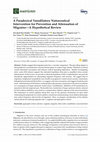
Nutrients
Studies suggest that migraine pain has a vascular component. The prevailing dogma is that periphe... more Studies suggest that migraine pain has a vascular component. The prevailing dogma is that peripheral vasoconstriction activates baroreceptors in central, large arteries. Dilatation of central vessels stimulates nociceptors and induces cortical spreading depression. Studies investigating nitric oxide (NO) donors support the indicated hypothesis that pain is amplified when acutely administered. In this review, we provide an alternate hypothesis which, if substantiated, may provide therapeutic opportunities for attenuating migraine frequency and severity. We suggest that in migraines, heightened sympathetic tone results in progressive central microvascular constriction. Suboptimal parenchymal blood flow, we suggest, activates nociceptors and triggers headache pain onset. Administration of NO donors could paradoxically promote constriction of the microvasculature as a consequence of larger upstream central artery vasodilatation. Inhibitors of NO production are reported to alleviate migr...
Frontiers in Behavioral Neuroscience
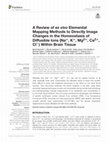
Frontiers in Neuroscience
Diffusible ions (Na + , K + , Mg 2+ , Ca 2+ , Cl −) are vital for healthy function of all cells, ... more Diffusible ions (Na + , K + , Mg 2+ , Ca 2+ , Cl −) are vital for healthy function of all cells, especially brain cells. Unfortunately, the diffusible nature of these ions renders them difficult to study with traditional microscopy in situ within ex vivo brain tissue sections. This mini-review examines the recent progress in the field, using direct elemental mapping techniques to study ion homeostasis during normal brain physiology and pathophysiology, through measurement of ion distribution and concentration in ex vivo brain tissue sections. The mini-review examines the advantages and limitations of specific techniques: proton induced X-ray emission (PIXE), X-ray fluorescence microscopy (XFM), secondary ion mass spectrometry (SIMS), laser-ablation inductively coupled plasma mass spectrometry (LA-ICP-MS), and the sample preparation requirements to study diffusible ions with these methods.
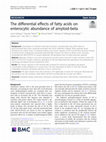
Lipids in Health and Disease
Background Consumption of a Western-styled diet enriched in saturated fatty acids (SFA) relative ... more Background Consumption of a Western-styled diet enriched in saturated fatty acids (SFA) relative to polyunsaturated fatty acids is positively associated with risk for Alzheimer’s disease. Whilst potential causal mechanism are unclear, there is increasing evidence that chronic ingestion of SFA enriched diets promote increase the plasma levels of lipoprotein-associated amyloid-β (Aβ). However, the effects of dietary mono- and poly-unsaturated fats (MUFA/PUFA) on nascent lipoprotein Aβ abundance have not been previously reported. Methods Wild-type C57BL/6 J mice were maintained on low-fat control chow (LF) or diets enriched in either SFA, MUFA, or PUFA for 9 months. Enterocytic abundance of Aβ was determined with quantitative immunofluorescent microscopy and plasma Aβ was measured by ELISA. Results The chronic ingestion of SFA-enriched diet increased the enterocytic abundance and plasma concentration of Aβ compared to LF control mice. The mice maintained on MUFA or PUFA diet showed com...
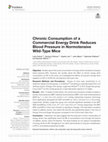
Frontiers in Nutrition
Objective: Studies report that acute consumption of energy drinks transiently increases blood pre... more Objective: Studies report that acute consumption of energy drinks transiently increases blood pressure (BP). However, few studies report the effect of chronic energy drink consumption on BP. In this study, we investigated the effects of long-term energy drink ingestion on BP in C57BL/6J normotensive wild-type mice. Research Methods and Procedures: Groups of mice were randomized to no treatment (water) (Control group), or to Mother TM provided as a decarbonated 30% (v/v) drinking solution (Energy Drink group), sugar-free Mother TM at 30% (Sugar-free group), Coca Cola TM at 30% (Coke group) for a total intervention period of 13 weeks. Results: After 13 weeks of intervention, the control mice showed a modest increase in systolic blood pressure (SBP), diastolic blood pressure (DBP), and mean arterial pressure (MAP) by 7.1 ± 8.8, 5.8 ± 9.4, and 6.3 ± 9.1 mmHg, respectively. However, the Energy Drink significantly decreased the DBP and MAP by 18.8 ± 9.9 and 15.3 ± 9.8 mmHg, respectively. Similarly, Sugar-free group mice showed significant decrease of the SBP, DBP, and MAP by 10.85 ± 5.6, 18.7 ± 6.7, and 15.6 ± 6.1 mmHg, respectively. The SBP, DBP, and MAP in Coke mice showed no significant changes. The estimated cumulative intake of caffeine, taurine, and vitamin B3 and B5 was significantly higher in the mice of Energy Drink and Sugar-free groups compared to the Control and Coke mice. Conclusion: Collectively, the data suggest that the long-term chronic consumption of energy drinks may significantly lower the BP in normotensive mice through the actions of caffeine, taurine, and/or B-vitamins. The study findings do not support consideration of energy drinks for BP management, but rather demonstrate no long-term amplification of BP in normotensive preclinical models.
ACS Chemical Neuroscience

Therapeutic Delivery
Aim: To enhance the bioavailability and brain uptake of probucol and examine whether it attenuate... more Aim: To enhance the bioavailability and brain uptake of probucol and examine whether it attenuates neuroinflammation and neurodegeneration by utilizing a sodium alginate nanoencapsulation technique. Materials & methods: Wild-type mice were given either low-fat standard chow, high-fat (HF) diet to induce neuroinflammation and neurodegeneration, HF diet supplemented with nanocapsuled probucol at a concentration of 0.1% (w/w), HF diet supplemented with noncapsulated probucol at the same concentration of 0.1%, or HF diet supplemented with noncapsulated probucol at higher concentration (1%) for 24 weeks. Results & conclusion: The nanoencapsulation increased the plasma and brain concentration of probucol significantly compared with the mice that was given the same dosage of probucol without capsulation, and significantly suppressed the neuroinflammation and neurodegeneration.
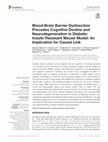
Frontiers in Aging Neuroscience
Diabetic insulin resistance and pro-diabetic diet are reported to increase dementia risk through ... more Diabetic insulin resistance and pro-diabetic diet are reported to increase dementia risk through unknown mechanisms. Emerging evidence suggests that the integrity of blood-brain barrier (BBB) is central to the onset and progression of neurodegeneration and cognitive impairment. Therefore, the current study investigated the effect of pro-diabetic diets on cognitive dysfunction in association to BBB integrity and its putative mechanisms. In C57BL/6J mice chronically ingested with a diet enriched in fat and fructose (HFF), Morris Water Maze (MWM) test indicated no significant cognitive decline after 4 weeks of HFF feeding compared to low-fat (LF) fed control. However, at this stage, BBB dysfunction accompanied by heightened neuroinflammation in cortex and hippocampal regions was already evident. After 24 weeks, HFF fed mice showed significantly deteriorated cognitive function concomitant with substantial neurodegeneration, which both showed significant associations with increased BBB permeability. In addition, the data indicated that the loss of BBB tight junctions was significantly associated with heightened inflammation and leukocyte infiltration. The data collectively suggest that in mice maintained on pro-diabetic diet, the dysfunctional BBB associated to inflammation and leukocyte recruitment precedes the neurodegeneration and cognitive decline, possibly indicating causal association.
Progress in Lipid Research
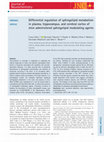
Journal of neurochemistry, 2017
Accumulation of ceramide is implicated in mediating the cellular responses to stress and aberrant... more Accumulation of ceramide is implicated in mediating the cellular responses to stress and aberrant sphingolipid metabolism is frequently associated with metabolic and neurodegenerative diseases. It is often assumed that (i) peripheral disturbances in sphingolipid concentrations are reflective of processes occurring in the brain, or (ii) circulating sphingolipids directly influence cerebral sphingolipid abundance. In order to address these assumptions, this study explores, in a physiological system, the metabolic pathways regulating sphingolipid metabolism in the brain and plasma of mice. Male C57Bl/6 were maintained on a low fat (control diet) or saturated fat enriched (SFA) diet with, or without the provision of sphingolipid modulating agents. Following 6 months of feeding, the abundance of seven sphingolipid classes was assessed by LC-ESI-MS/MS in the hippocampus (HPF), cerebral cortex (CTX), and plasma. Long-term consumption of the SFA diet increased ceramide and dihydroceramide i...
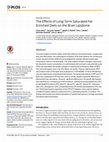
PloS one, 2016
The brain is highly enriched in lipids, where they influence neurotransmission, synaptic plastici... more The brain is highly enriched in lipids, where they influence neurotransmission, synaptic plasticity and inflammation. Non-pathological modulation of the brain lipidome has not been previously reported and few studies have investigated the interplay between plasma lipid homeostasis relative to cerebral lipids. This study explored whether changes in plasma lipids induced by chronic consumption of a well-tolerated diet enriched in saturated fatty acids (SFA) was associated with parallel changes in cerebral lipid homeostasis. Male C57Bl/6 mice were fed regular chow or the SFA diet for six months. Plasma, hippocampus (HPF) and cerebral cortex (CTX) lipids were analysed by LC-ESI-MS/MS. A total of 348 lipid species were determined, comprising 25 lipid classes. The general abundance of HPF and CTX lipids was comparable in SFA fed mice versus controls, despite substantial differences in plasma lipid-class abundance. However, significant differences in 50 specific lipid species were identifi...
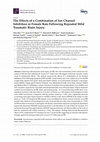
International Journal of Molecular Sciences
Following mild traumatic brain injury (mTBI), the ionic homeostasis of the central nervous system... more Following mild traumatic brain injury (mTBI), the ionic homeostasis of the central nervous system (CNS) becomes imbalanced. Excess Ca2+ influx into cells triggers molecular cascades, which result in detrimental effects. The authors assessed the effects of a combination of ion channel inhibitors (ICI) following repeated mTBI (rmTBI). Adult female rats were subjected to two rmTBI weight-drop injuries 24 h apart, sham procedures (sham), or no procedures (normal). Lomerizine, which inhibits voltage-gated calcium channels, was administered orally twice daily, whereas YM872 and Brilliant Blue G, inhibiting α-amino-3-hydroxy-5-methyl-4-isoxazolepropionic acid (AMPA) and P2X7 receptors, respectively, were delivered intraperitoneally every 48 h post-injury. Vehicle treatment controls were included for rmTBI, sham, and normal groups. At 11 days following rmTBI, there was a significant increase in the time taken to cross the 3 cm beam, as a sub-analysis of neurological severity score (NSS) ass...

Critical Reviews in Clinical Laboratory Sciences, 2015
An increasing body of evidence suggests that cerebrovascular dysfunction and microvessel disease ... more An increasing body of evidence suggests that cerebrovascular dysfunction and microvessel disease precede the evolution of hallmark pathological features that characterise Alzheimer's disease (AD), consistent with a causal association for onset or progression. Recent studies, principally in genetically unmanipulated animal models, suggest that chronic ingestion of diets enriched in saturated fats and cholesterol may compromise blood-brain barrier (BBB) integrity resulting in inappropriate blood-to-brain extravasation of plasma proteins, including lipid macromolecules that may be enriched in amyloid-β (Aβ). Brain parenchymal retention of blood proteins and lipoprotein bound Aβ is associated with heightened neurovascular inflammation, altered redox homeostasis and nitric oxide (NO) metabolism. Therefore, it is a reasonable proposition that lipid-lowering agents may positively modulate BBB integrity and by extension attenuate risk or progression of AD. In addition to their robust lipid lowering properties, reported beneficial effects of lipid-lowering agents were attributed to their pleiotropic properties via modulation of inflammation, oxidative stress, NO and Aβ metabolism. The review is a contemporary consideration of a complex body of literature intended to synthesise focussed consideration of mechanisms central to regulation of BBB function and integrity. Emphasis is given to dietary fat driven significant epidemiological evidence consistent with heightened risk amongst populations consuming greater amounts of saturated fats and cholesterol. In addition, potential neurovascular benefits associated with the use of hypolipidemic statins, probucol and fenofibrate are also presented in the context of lipid-lowering and pleiotropic properties.










Uploads
Papers by Ryusuke Takechi